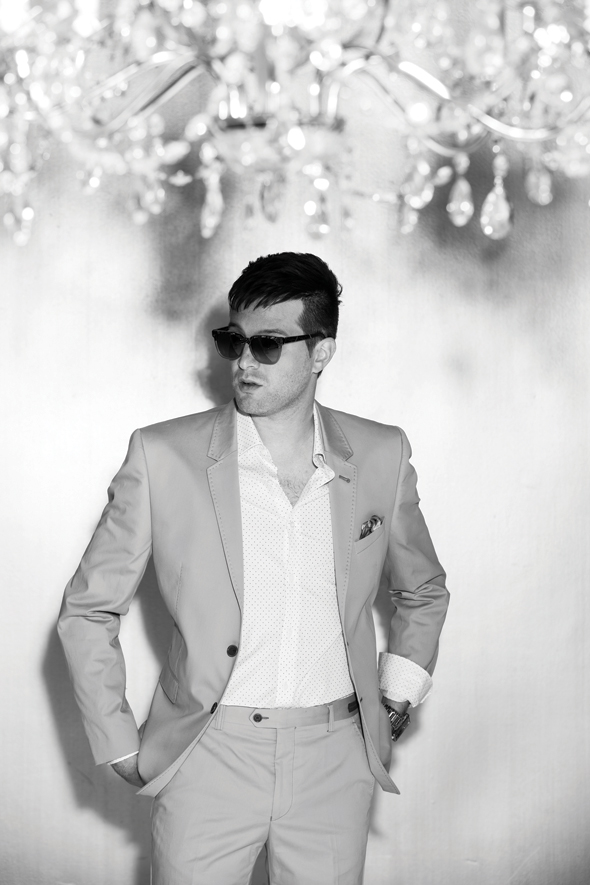
At a coffee house filled with Silverlake hipsters, Mayer Hawthorne blends right in. When mentioning the crooner’s name to anyone, the general response is: “Mayer Hawthorne is great.” The 30-something Ann Arbor, Michigan native and Los Angeles transplant is, inarguably, great. What Hawthorne hears the most upon meeting people, however, is, “I thought you were black.”
Born Andrew Mayer Cohen, the borderline translucent Hawthorne named his soul-singing alter ego using his middle name and the name of the street on which he grew up. His prior incarnation was a hip hop DJ under the nom de plume Haircut. His classic style, a reverent homage to Motown, revolves around bitter break-up songs. This caught the attention of Peanut Butter Wolf who based on hearing two tracks commissioned an album for his Stone’s Throw label. With the release of his debut, A Strange Arrangement, Hawthorne ensconced himself in the public consciousness. He followed that up with How Do You Do. Now on a major label, the album, like its predecessor, was produced entirely by Hawthorne. He has a hand in every area from instruments to back-up vocals—plus it includes a guest appearance by Snoop Dogg, singing no less, on “Can’t Stop.”
Now, the snazzy Hawthorne, wearing fitted, colored jeans, a jumper with zippers on the shoulders, and sunglasses that look like they were swiped off his great-aunt’s dresser, is ready with his third full-length, Where Does This Door Go. Bending down to snap a photo of a door under the stairs winding up the side of the coffee house, he muses, tongue-not-quite-in-cheek, “Where you do you think that door goes?”
Where Does This Door Go is not about break-ups. Instead, it reflects on Hawthorne’s coming-of-age, that is, high school. A time of extreme highs and lows, his interpretation is with 20/20 hindsight, which means many a chuckle back at his teenage self. For the first time, Hawthorne has allowed other producers’ involvement, namely, multiple Grammy Award-winning and -nominated hitmakers Pharrell Williams, Jack Splash, Oak, and Greg Wells. The result: R&B-lite of “Her Favorite Song” (featuring Jessie Ware) interrupted by giggle-inducing flatulent horn blasts while “The Stars Are Ours” is a bouncy this-is-what-happened-last-night story and “Crime” (featuring Kendrick Lamar) is the summertime song to play while sitting atop the convertible tailgates. The inclusion of random bits of hormone-driven conversation with splashes of hip hop on “Problematization” and “Wine Glass Woman” make Where Does This Door Go all that much more humorous.
“I can’t do the same thing twice. It’s got to evolve and move forward,” says Hawthorne, the sun revealing red hairs amongst his stubble as he leans against the glass wall of the Silverlake Conservatory. “I met with far more producers than I worked with. In the end, I chose the guys I felt were the most musical and could understand my vision, but at the same time would push me to do new things. Anytime I work with anyone, I want to do something that not only I’ve never done, but that they’ve never done, get something out of them that nobody’s heard before.”
In between albums Hawthorne has collaborated with French musician SebastiAn on “Love In Motion”—unlikely pairing—and Booker T. Jones—likely pairing—among others. Following his abovementioned guidelines, Hawthorne made sure the latter, for whom he vocalized the title track of Sound The Alarm, is something unexpected from the both of them. Yet Hawthorne still sees his role as a singer something he is working on getting comfortable with.
“I always remember this quote from Marvin Gaye from the prime of his career where he says, ‘I hope to one day become a great singer.’” Hawthorne states as the light glints off an eye-catching owl ring on his finger. “They say it takes 10,000 hours to master a craft. I don’t think I will ever look at myself as an accomplished singer. I will always be trying to be better at my instrument.
Instruments, the conventional kind, have been part of Hawthorne’s life since he was old enough to sit at a piano stool. Taking lessons at a place very similar to the one he is leaning against, he also picked up the drums, and learned bass from his father, who played in a band—and still does. It was his father who pushed Hawthorne towards education as a fallback to the notoriously unstable life of a musician.
“Definitely one of the biggest misconceptions about me is that I’m some sort of throwback character that lives in a ‘60s time warp where I only listen to Otis Redding on vinyl,” he says. “It couldn’t be further from the truth. I have a computer science degree. I have an iPad. I listen to MP3s all the time. And I listen to Gary Numan and a lot of heavy metal music. I like sci-fi films. I live in 2014.”
Text by Lily Moayeri
Photography by Jeremy Dupetat

